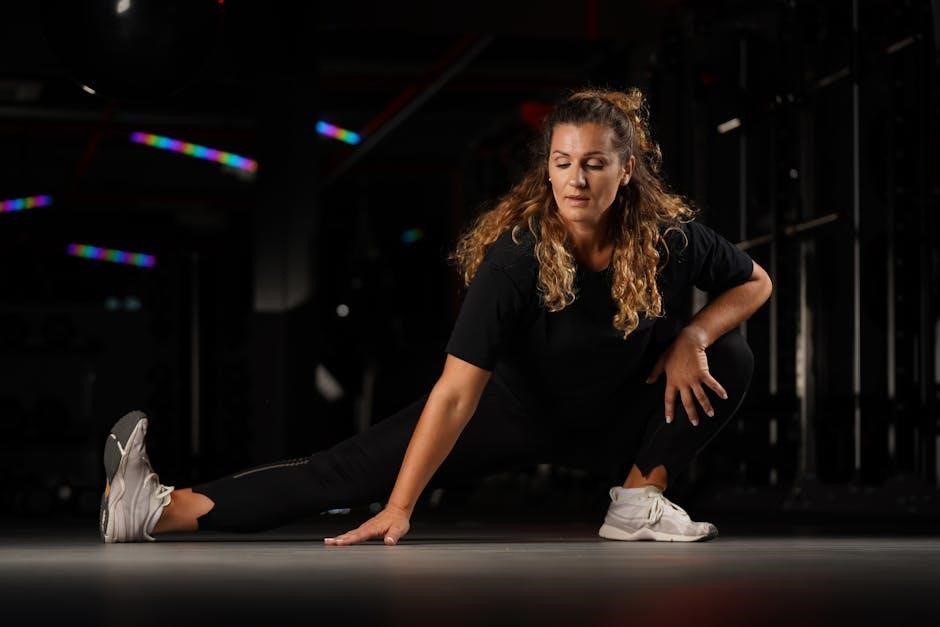Scapular strengthening exercises are essential for improving shoulder stability, posture, and overall upper body strength. They target the muscles around the shoulder blades, enhancing movement efficiency and reducing injury risk.

1.1 Importance of Scapular Strength for Shoulder Health
Scapular strength is crucial for maintaining proper shoulder function and preventing injuries. Weak or unstable shoulder blades can lead to poor posture, shoulder impingement, and reduced athletic performance. Strengthening the scapular muscles, such as the trapezius and rhomboids, helps provide a stable base for the shoulder joint, improving movement mechanics and reducing the risk of injuries like rotator cuff strains. Strong scapular muscles also enhance overall upper body strength, making daily activities and sports easier and safer. Neglecting scapular strength can lead to chronic shoulder pain and limited mobility, emphasizing the need for targeted exercises.
1.2 Benefits of Scapular Strengthening Exercises
Scapular strengthening exercises offer numerous benefits, including improved posture, enhanced athletic performance, and injury prevention. Strong shoulder blades provide better stability for the shoulder joint, reducing the risk of strains and impingement. These exercises also improve muscle balance, alleviating discomfort from poor posture or repetitive movements. Additionally, they enhance overall upper body strength, making daily activities and sports easier. Strengthening the scapular muscles can also boost confidence and mobility, allowing for a fuller range of motion and reducing the likelihood of chronic shoulder pain. Regular practice promotes long-term shoulder health and resilience.

Key Scapular Strengthening Exercises
Key exercises include Scapular Hold, Wall Press-Up, Prone Shoulder Blade Squeezes, and Supported Press-Ups. These exercises improve posture, strength, and stability, targeting the scapular muscles effectively.
2.1 Scapular Hold (Shoulder Blade Squeeze)
The Scapular Hold, or Shoulder Blade Squeeze, is a fundamental exercise that strengthens the muscles between the shoulder blades. To perform it, stand or sit with arms at your sides. Engage your core, then squeeze your shoulder blades together as if pinching a pencil between them. Hold for 5-10 seconds, breathing naturally. Repeat for 10-15 repetitions. This exercise improves posture, reduces shoulder tension, and enhances overall scapular stability, making it ideal for beginners and athletes alike. Consistency is key for optimal results.
2;2 Wall Press-Up
The Wall Press-Up is a simple yet effective exercise for scapular strengthening. Stand facing a wall, hands shoulder-height, and slowly lower your body toward the wall, keeping elbows close to your sides. Push back to the starting position, squeezing your shoulder blades together. Perform 10-15 repetitions. This exercise targets the scapular stabilizers, improving shoulder blade control and posture. It’s low-impact, making it ideal for those with shoulder concerns or beginners. Focus on slow, controlled movements to maximize the effectiveness of the exercise and avoid strain. Regular practice strengthens the muscles around the shoulder blades, enhancing overall shoulder health and stability.
2.3 Prone Shoulder Blade Squeezes
Prone Shoulder Blade Squeezes are an excellent exercise for strengthening scapular muscles. Lie on your stomach with arms at your sides, palms down. Engage your core and slowly squeeze your shoulder blades together, holding for 5 seconds. Release and repeat for 10-15 repetitions. This exercise targets the rhomboids and trapezius muscles, improving posture and shoulder stability. Focus on controlled movements and avoid arching your neck or lower back. Perform 2-3 sets daily to enhance scapular strength and reduce the risk of shoulder injuries. It’s a simple, effective exercise that can be done anywhere without equipment.
2.4 Supported Press-Ups
Supported Press-Ups are a modified version of traditional push-ups, designed to strengthen the scapular muscles while reducing strain on the shoulders. Start by placing your hands on a stable surface, such as a chair or bench, with your feet on the floor. Engage your core, lower your chest toward the surface, and press back up, squeezing your shoulder blades together. This exercise targets the scapular stabilizers and trapezius muscles. Focus on maintaining proper form to avoid shoulder impingement. Supported Press-Ups are ideal for those building foundational strength or recovering from injuries, offering a controlled way to improve scapular control and overall upper body stability.

3.Progression and Variation of Exercises
Progression and Variation of Exercises
Exercises can be adapted to suit different fitness levels by incorporating resistance bands or increasing difficulty over time, ensuring continued progress and avoiding plateaus.
3.1 Incorporating Resistance Bands
Resistance bands are a versatile tool for enhancing scapular strengthening exercises. They provide adjustable tension, allowing for progressive overload to build muscle strength over time. Start with lighter bands and gradually increase resistance as strength improves. Exercises like banded shoulder blade squeezes or rows can be performed with bands anchored to a stable object. This method helps target specific muscle groups, improving scapular stability and posture. Resistance bands are portable and cost-effective, making them ideal for both home and clinical settings. Regular use can enhance exercise variety and keep workouts engaging while promoting consistent progress.
3.2 Increasing Difficulty Over Time

As strength improves, gradually increase exercise difficulty to continue challenging the scapular muscles. This can be achieved by adding resistance, such as using heavier bands or weights, or by increasing the number of repetitions or sets. Additionally, reducing support during exercises, like transitioning from supported press-ups to full press-ups, can enhance difficulty. Progressing to single-arm or dynamic movements also effectively elevates the challenge. Always maintain proper form and avoid pain. Regular progression ensures continued strength gains and improved scapular stability, helping to prevent plateaus and keep workouts effective.

Safety and Guidelines
Always warm up before exercises and use proper form to prevent injury. Stop if pain occurs and consult a professional for personalized advice.
4.1 Proper Form and Technique
Proper form is crucial for effective scapular strengthening. Start with a neutral spine and engage core muscles to stabilize the body. For exercises like scapular holds, squeeze shoulder blades together without shrugging. In wall press-ups, maintain straight arms and focus on scapular movement. During prone shoulder blade squeezes, lie flat and avoid arching the back. Use controlled movements and avoid compensating with other muscle groups. Ensure exercises are pain-free and performed with full range of motion. Proper technique prevents injury and maximizes muscle activation, promoting optimal scapular strength and stability.
4.2 Avoiding Common Mistakes
Common mistakes in scapular exercises include using too much resistance too soon, neglecting proper form, and compensating with other muscles. Avoid shrugging shoulders during exercises like scapular holds. Do not arch the back or use momentum, as this reduces effectiveness and increases injury risk. Ensure core muscles are engaged to maintain stability. Start with lower resistance and gradually progress. Focus on controlled, slow movements rather than quick or jerky actions. Ignoring proper warm-up or cooldown can also lead to discomfort or injury. Awareness of these mistakes helps optimize results and ensures safe, effective scapular strengthening.
The Role of Core Strength in Scapular Stability
Core strength is vital for scapular stability, providing a stable base for shoulder movements, enhancing posture, and reducing injury risks during exercises effectively.
5.1 Link Between Core and Scapular Function
The core and scapula are intricately linked, as a stable core provides the foundation for efficient scapular movement. Weak core muscles can lead to poor posture and shoulder instability, increasing the risk of injury. Strengthening the core enhances scapular function by improving control and coordination during movements. This connection is crucial for maintaining proper shoulder mechanics, preventing imbalances, and optimizing overall upper body strength. A strong core supports the scapula, ensuring smooth, injury-free motion in daily activities and exercises.

Daily Routine for Consistency
Perform scapular exercises 1-2 times daily, 5 times a week, starting with 5-10 repetitions and gradually increasing. Consistency ensures lasting improvements in shoulder stability and strength.

6.1 Recommended Frequency and Duration
Perform scapular strengthening exercises 1-2 times daily, 5 times a week, for optimal results. Start with 5-10 repetitions and 3 sets, gradually increasing as strength improves. Each session should last 10-15 minutes, allowing for proper warm-up and cool-down. Focus on controlled movements to maximize muscle engagement. If exercises become too easy, increase resistance or repetitions. Consistency is key to achieving lasting improvements in shoulder stability and posture. Incorporate these routines into your daily schedule to enhance overall shoulder health and function effectively.

6.2 Tips for Sticking to the Routine
Establish a structured schedule and dedicate a specific time daily for exercises. Create a conducive environment free from distractions to maintain focus. Use reminders or alarms to ensure consistency. Track progress with a workout journal to stay motivated. Incorporate a brief warm-up and cool-down to prevent fatigue. Start with manageable sets and gradually increase intensity. Pair exercises with daily activities, like during commercial breaks while watching TV. Reward small milestones to maintain enthusiasm. Stay hydrated and ensure proper rest to support muscle recovery. Consistency and patience are key to achieving long-term scapular strength and stability.
Scapular strengthening exercises are a cornerstone of improving shoulder health and overall upper body stability. By incorporating exercises like scapular holds, wall press-ups, and prone shoulder blade squeezes, individuals can enhance posture, reduce injury risk, and boost athletic performance. Consistency is key, with daily routines and proper form ensuring lasting benefits. The link between core strength and scapular function highlights the importance of a holistic approach. Patience and dedication will yield noticeable improvements in shoulder stability and movement efficiency, making these exercises a valuable investment in long-term musculoskeletal health.

Leave a Reply
You must be logged in to post a comment.